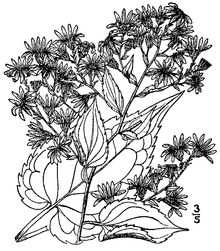- Symphyotrichum cordifolium
-
Symphyotrichum cordifolium 
Heartleaf Aster Conservation status Scientific classification Kingdom: Plantae (unranked): Angiosperms (unranked): Eudicots (unranked): Asterids Order: Asterales Family: Asteraceae Subfamily: Asteroideae Tribe: Astereae Genus: Symphyotrichum Species: S. cordifolium Binomial name Symphyotrichum cordifolium
(L.) G.L.NesomSynonyms Aster cordifolius L.
Aster cordifolius L., var. Furbishiae.
Aster plumarius Burgess
Aster sagittifolius Wedemeyer ex Willd.
Symphyotrichum sagittifolium (Wedemeyer ex Willd.) G.L. Nesom
Sources: NatureServe,[1] IPNI[2] NRCS[3]Symphyotrichum cordifolium, commonly known as the Heartleaf Aster or Common Blue Wood Aster, is an herbaceous perennial native to eastern North America, where it is present from Manitoba in Canada, east to Nova Scotia and south through the United States to Georgia. It can be readily found in mesic habitats along forest edges and in open areas, as well in urban areas where it grows as a weed. It sometimes produces a naturally occurring hybrid with S. puniceum named S. ×tardiflorum where their ranges overlap. The flowers, which typically have bluish to rarely white ray florets and light yellow disc florets that eventually turn purple, emerge in August and persist into October.
Distribution and habitat
S. cordifolium is present in a wide areas within eastern North America. It can be found from Manitoba in the north west, east to Nova Scotia and Maine, south to Georgia and Alabama and west to Oklahoma. It grows primarily in mesic sites with soils that are rocky to loamy, but generally rich, at heights ranging from sea level along the coastal plain up to 1200 metres in the Appalachians. It can be found on open wooded slopes, along the banks of streams, on moist ledges, in swampy woods, along the borders of beech-maple and oak-hickory forests, as well as in clearings, thickets and along roadsides and ditches. It can also be found in urban areas where it is occasionally encountered as a weed species.[4]
References
- ^ "Symphyotrichum cordifolium". NatureServe Explorer. NatureServe. http://www.natureserve.org/explorer/servlet/NatureServe?searchName=Symphyotrichum+cordifolium+. Retrieved 2007-06-15.
- ^ International Organization for Plant Information (IOPI). "Plant Name Search Results" (HTML). International Plant Names Index. http://www.ipni.org/ipni/idPlantNameSearch.do?id=981790-1. Retrieved 2008-06-07.
- ^ "Symphyotrichum cordifolium". Natural Resources Conservation Service PLANTS Database. USDA. http://plants.usda.gov/java/profile?symbol=SYCO4. Retrieved 2008-06-08.
- ^ Brouillet, Luc; Semple, John C.; Allen, Geraldine A.; Chambers, Kenton L.; Sundberg, Scott D. (2006). "Symphyotrichum cordidolium". In Flora of North America Editorial Committee, eds. 1993+. Flora of North America. 20. New York & Oxford: Oxford University Press. pp. 501. http://www.efloras.org/florataxon.aspx?flora_id=1&taxon_id=250067634.
Categories:- NatureServe Secure species
- Symphyotrichum
- Flora of the Southeastern United States
- Flora of the Northeastern United States
- Flora of the North-Central United States
- Flora of Eastern Canada
- Flora of British Columbia
Wikimedia Foundation. 2010.

